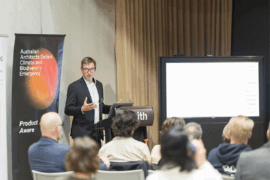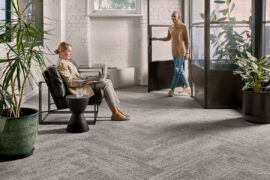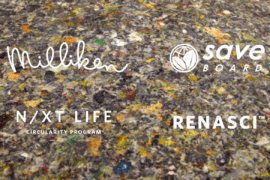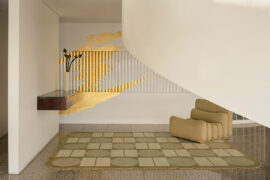As modulyss’ latest ranges grace Australian shores, we look at how they might just be the market-leaders in carpet design for rhythm and motion.
The creative world’s interest in rhythm and motion is nothing new.
From Duchamp’s sepia-toned Nude Descending a Staircase to the dynamism of Balla’s Dog on a Leash and the torrid image of Boccioni’s city as it rises, imparting a sense of motion has long fascinated artists. So too has it enchanted architects and designers, perhaps none more than Adolf Loos. In 1927, the Czech-Austrian architect designed a home for Josephine Baker – dancer, singer, and later French Resistance agent – that featured at its heart a giant glass tank in which Ms Baker could perform underwater dance routines for her guests. Never realised, the home was nonetheless a fascinating study of the pas de deux between motion and design, with the plans literally drawn around rhythm and dance.
One might speculate that at its core, the impulse to capture motion through design is a desire to conquer the unique challenge that this poses. There is a certain thrill to the seemingly impossible task of capturing the energy and unpredictability of motion – with its potential for both ethereal grace and spiky juddering – and communicating this somatic and visual phenomenon within a solid object. The paradox is enticing, and one that designers have attempted to master for years. And yet, problems arise from the inherently static nature of most design, with stillness having the potential to cause stagnation, even suffocation, of movement’s exuberant energy. Designers must grapple with the question of not only capturing rhythm and motion, but also reflecting and embodying these in a meaningful, psychologically and somatically poignant way.
Before a ballerina springs into assemblé, a leap that will see her land on two feet, one foot must first glide out to the side in a battement glissél dégagé. She then launches herself up with the foot remaining on the floor, brings this foot up to meet the foot that is out to the side, then lands lightly on both feet, which are spread into a narrow ‘v’ shape. When executed properly, the assemblé is fluid, seemingly effortless, the minutia and controlled steps that precede it going unnoticed.
Thus is the parallel nature of design where, if done well, the countless iterations and corrections that come before a final product will not be heard of. It is rare that a designer will be struck by an idea, already fully formed, that resolves every aspect of their brief; rarer still that the final object will exactly resemble the initial idea. Design, like dance, is a skill that must be practiced until, gradually, no beat is missed and one learns to adapt to sudden, startling changes in rhythm. The best designs do not betray the effort or preparation that went into them. They simply work, and are a joy to watch in action.
But approaching a working definition of rhythm in design has proven to be more difficult than we might otherwise expect. In general, theorists tease out characteristics of patterned recurrence, repetition or movement in action (regular or irregular), emerging from the categories of line, shape, form, colour, light, shadow, and sound. And yet, rhythm in design remains an experiential phenomenon – one that requires an end-user to be allowed to perambulate a structure, usually visually, however also through the potential engagement of all senses. As such, rhythm becomes the product of sensory information, causing a concatenation of proprioceptive, somatic and psychological responses. György Kepes, a Hungarian artist known mainly in design circles as the frequent collaborator with László Moholy-Nagy, an early Bauhaus member, first drew attention to this incredibly rich physical and psychological responsiveness to rhythm in design in his 1944 treatise Language of Vision:
“The orderly repetition or regular alternation of optical similarities or equalities dictates the rhythm of the plastic organisation. In recognising such order one learns when the next eye action is due and what particular neuromuscular adjustment will be necessary to grasp the next unit. To conserve the attentive energies of vision, therefore, the picture surface must have a temporal structure of organisation—it must be rhythmically articulated in a way that corresponds, for the eye, to the rhythm of any work process.”
Motion and Vision, two new ranges of carpet tiles from modulyss, have been met with mass critical acclaim in the world of A+D for precisely their extreme capacity to explore and reimagine these “neuromuscular adjustments” in end-user experience. The tiles do not just mimic motion, nor do they merely evoke rhythmical patterns. Feel like your space needs a tempo change part way? No problem – all thirteen designs in Vision can be mixed and matched with the twelve in Motion. Want to break up the pattern a little? Sure! Do a quarter-turn of any tile and watch “picture surface” and the end-user’s “neuromuscular adjustments” change completely. Once more, modulyss syncopates the conventional design rhythm, to staggering, eye-catching effect.
The new ranges are exuberant celebrations of the transformative effect that movement and energy, in all their forms, can have on an interior space. The vivid carpet tiles dance across the colour spectrum, pirouetting through punk greens and petrol blues and cha-cha-ing to chartreuse and crimson. In a single fluid motion, lines shift languidly into texture, giving way to geometric patterns that burst forth in colourful, arresting blooms. If Motion’s gradients are driven by a thrumming beat that grows steadily faster, Vision’s mottled surface is the allegro at the end of a song, the dancer leaping from the stage.
Both ranges also boast sustainability credentials that are in step with their design appeal, and are made using 48% overall recycled content. Keeping with the beat of modulyss’ considered approach to design, the entire manufacturing process is carefully managed to be as seamless and environmentally friendly as possible. 100% green electricity is used during production, generated from renewable resources such as modulyss’ solar panels, and is supplemented by the company’s pioneering ‘back2back’ scheme. Under this scheme, waste from the tile cutting process is shredded and added to the secondary tile backing, giving it a 10% post-industrial recycled content. Leftover and waste yarns are also collected at the end of the manufacturing process and recycled into new yarns.
In the age of the open plan office and the customised fit out, the market for carpet in commercial environments shows no sign of slowing. It is more crucial than ever that all elements of design, including floors, become active parts of a zeitgeist that focuses on crafting spaces that benefit and inspire users. In a return to the Vitruvian trifecta of commodity, firmness, and delight, today’s commercial spaces privilege user comfort, wellbeing, and enjoyment of a space. Motion and Vision allow each of these things in turn, with a soft feel underfoot, solvent-free bitumen backing, and bold and unexpected designs. The ranges are a departure from the staid, greyscale palette of commercial flooring of bygone days, and a leap toward a colourful new future.
INDESIGN is on instagram
Follow @indesignlive
A searchable and comprehensive guide for specifying leading products and their suppliers
Keep up to date with the latest and greatest from our industry BFF's!

A curated exhibition in Frederiksstaden captures the spirit of Australian design

For Aidan Mawhinney, the secret ingredient to Living Edge’s success “comes down to people, product and place.” As the brand celebrates a significant 25-year milestone, it’s that commitment to authentic, sustainable design – and the people behind it all – that continues to anchor its legacy.

In a landscape clouded by data and greenwash, Product Aware offers architects and designers a common language for sustainability. Embraced by suppliers – including Milliken – it is setting a new benchmark for trust and bringing clarity and accountability to material specification.

The new Heritage Loom Collection weaves past and present together to capture the spirit of iconic fabric construction

Developed by Milliken in partnership with saveBOARD, Renasci™ is a breakthrough circular flooring product made from carpet and soft plastics waste – designed to be repeatedly recycled.

With the right inspiration and a few smart options, you can elevate your home and add comfort and style without making permanent changes. Discover how Carpet Court’s renter-friendly solutions can help you create a home that’s as unique as you are – no drill required.
The internet never sleeps! Here's the stuff you might have missed

The luxury vinyl plank collection from Godfrey Hirst includes three distinctive palettes – Olympus Neo, Olympus Parquet and Olympus Stone.

In the latest collaboration between Designer Rugs and Greg Natale, the raw rigour of modernist geometries finds its most comforting articulation in the inherent softness of floor coverings.